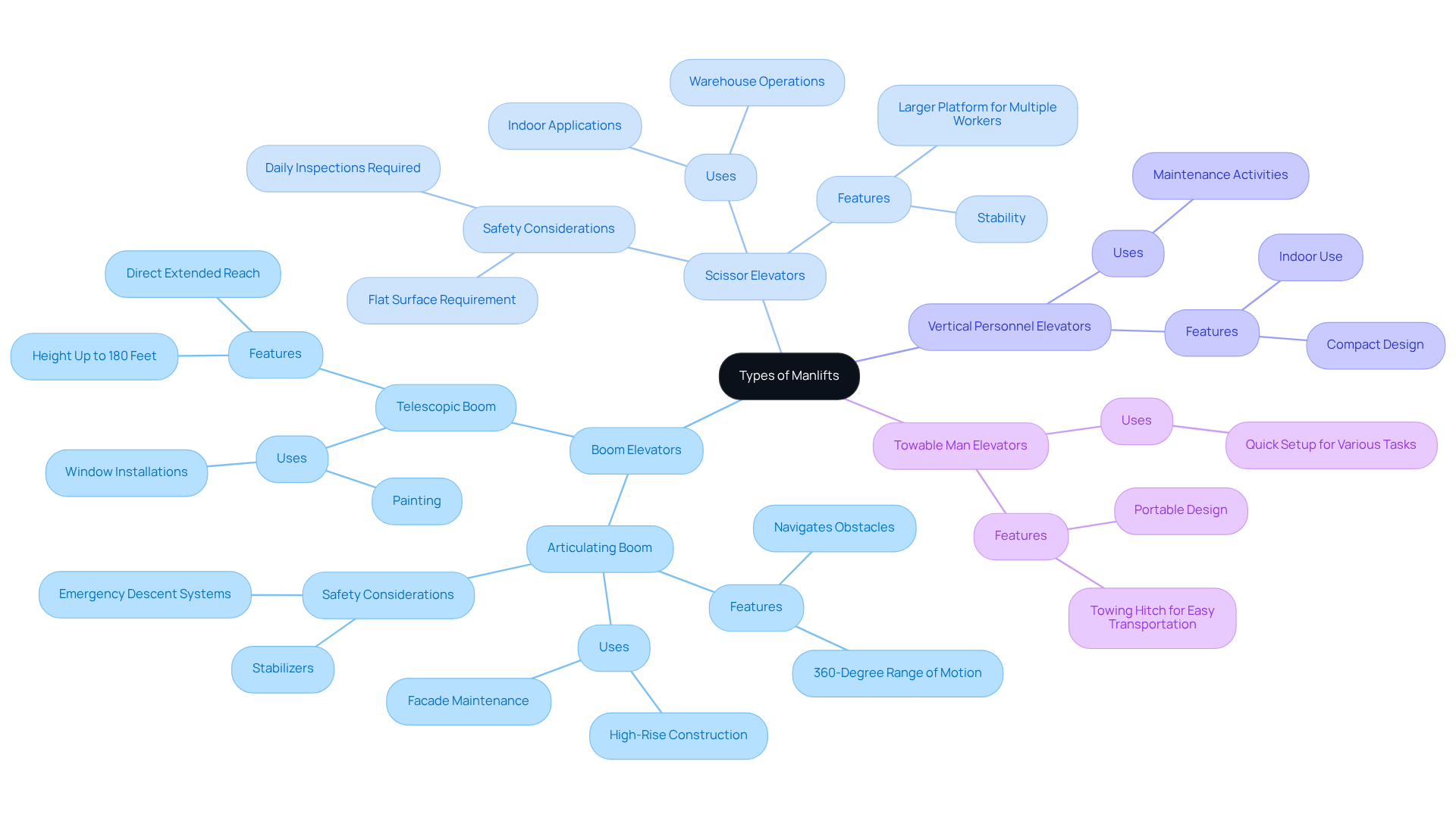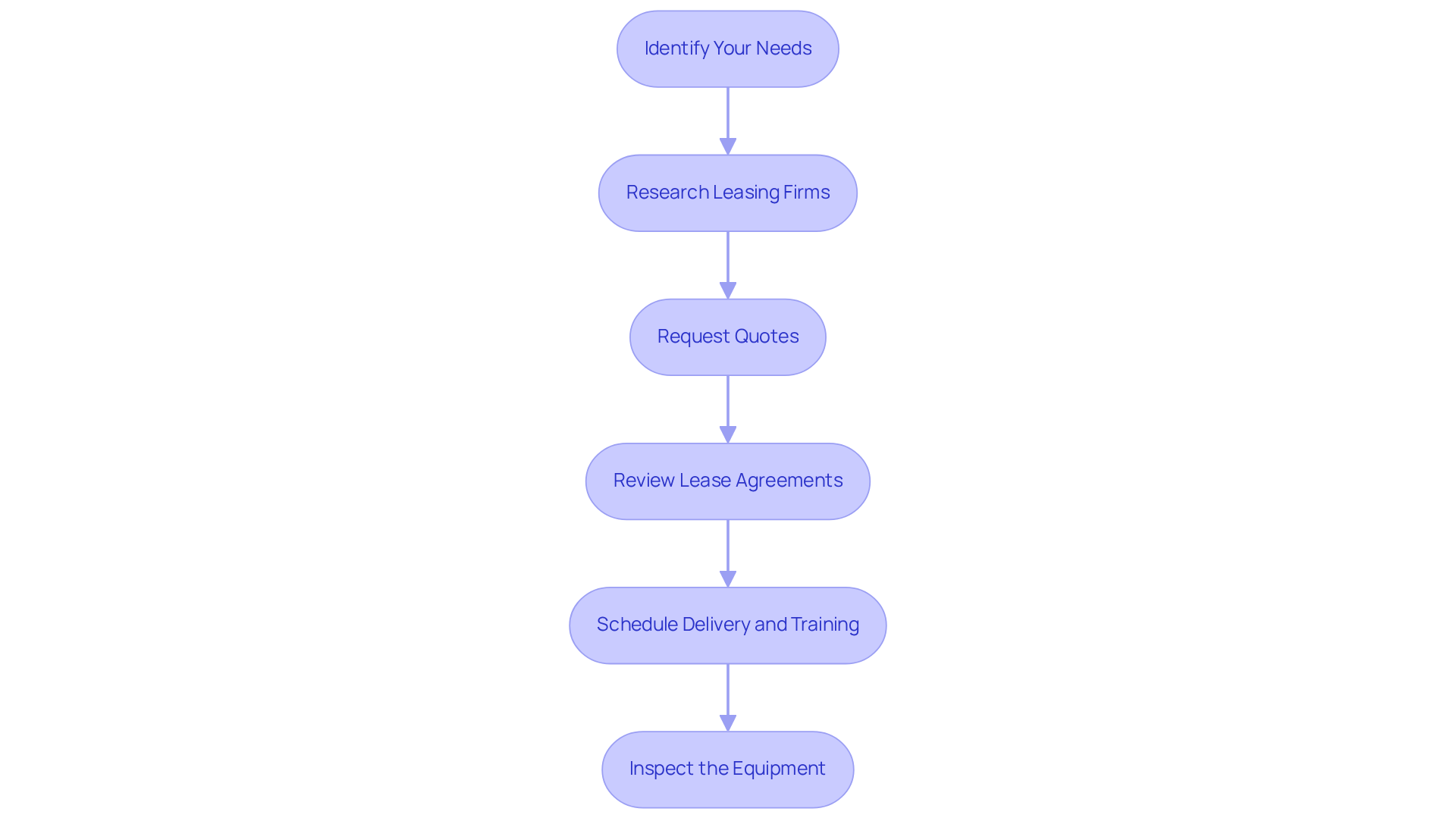Key Highlights:
- Boom Elevators are designed for significant heights, with articulating types navigating obstacles and telescopic types providing direct reach, effective for high-rise tasks.
- Scissor Elevators offer stability and larger platforms for multiple workers, ideal for indoor operations, reaching heights of 20 to 50 feet.
- Vertical Personnel Elevators are compact for indoor use, allowing access in confined spaces for maintenance tasks.
- Towable Man Elevators are portable and versatile, suitable for contractors needing quick setup and relocation.
- Key selection criteria include height requirements, load capacity, terrain conditions, indoor vs. outdoor use, and power source.
- Steps to secure a manlift rental involve identifying needs, researching leasing firms, requesting quotes, reviewing lease agreements, scheduling delivery and training, and inspecting the equipment.
Introduction
Understanding the complexities of manlift rentals is essential for project managers who want to boost operational efficiency and safety on job sites. This guide explores the different types of manlifts available, their specific applications, and the critical selection criteria that can determine the success of a project. With numerous options and factors to consider, how can you ensure that you select the right equipment while avoiding common pitfalls in the rental process?
In addition, we’ll provide insights into the benefits of each type of manlift, backed by statistics and case studies that highlight their reliability and quality. Testimonials from satisfied customers will further illustrate the value of making informed choices in equipment rentals. By the end of this guide, you’ll be equipped with the knowledge to make confident decisions that enhance your project outcomes.
Understand Different Types of Manlifts
Before renting a manlift, it's essential to understand the various types available:
-
Boom Elevators: Designed for reaching significant heights, boom elevators come in two main types: articulating and telescopic. Articulating boom devices excel at navigating obstacles, allowing access to hard-to-reach areas, while telescopic boom equipment offers a direct, extended reach. With capabilities to extend up to 180 feet, boom lifts are particularly effective for high-rise construction and maintenance tasks, providing both vertical and horizontal reach. Their exceptional reach makes them essential for tasks such as window installations, painting, and facade maintenance in urban development initiatives. Safety features like stabilizers and emergency descent systems enhance operational safety, making them a reliable choice for construction projects. Notably, the boom elevating equipment market is anticipated to expand from $11.8 billion in 2024 to $12.48 billion in 2025 at a CAGR of 5.8%, indicating their rising demand in the construction industry.
-
Scissor Elevators: Recognized for their stability, scissor elevators are perfect for vertical raising and feature a larger platform that accommodates multiple workers and equipment. They are best suited for flat surfaces, making them a preferred choice for indoor applications such as warehouse operations and maintenance tasks. Scissor platforms typically reach elevations of 20 to 50 feet and are categorized as mobile scaffolds, necessitating daily inspections and safety precautions.
-
Vertical Personnel Elevators: Compact and designed for indoor use, vertical personnel elevators allow operators to access heights in confined spaces. These platforms are frequently employed for maintenance activities, offering a secure and effective option for accessing high places without the requirement for elaborate preparation.
-
Towable Man Elevators: These portable devices can be easily towed between job sites, providing versatility for various tasks. Their mobility makes them a popular choice among contractors who require quick setup and relocation capabilities.
Understanding these types will allow you to choose the rental manlift that best fits your project's specific needs, considering factors such as height, reach, and terrain requirements. As the market for aerial work platforms continues to evolve, innovations in raising technology, including electric and hybrid models, are enhancing operational efficiency and safety. Stay informed about the latest trends to ensure you make the best choice for your project.

Evaluate Key Selection Criteria for Your Project
When it comes to selecting a manlift, it’s crucial to consider several key criteria to ensure you make the right choice for your project.
-
Height Requirements: First and foremost, determine the maximum height you need to reach. This factor significantly influences the type of lift you should select. Choosing the right height capability ensures safety and efficiency in your operations.
-
Load Capacity: Next, evaluate the total weight that the lift will need to transport, including both personnel and equipment. It’s essential to ensure that the manlift can safely manage this weight, as exceeding capacity can lead to dangerous situations.
-
Terrain Conditions: Additionally, assess the job site conditions. For rugged or uneven ground, a rough terrain scissor lift or boom lift may be necessary. Conversely, if your work area features smooth surfaces, standard equipment will suffice, providing versatility in your selection.
-
Indoor vs. Outdoor Use: Furthermore, consider whether the lift will be used indoors or outdoors. Some devices are specifically designed for indoor applications, while others are built to withstand outdoor conditions. Selecting the right type for your environment is vital for optimal performance.
-
Power Source: Lastly, think about the power source. Do you need a battery-operated lift for indoor tasks, or is a gas-powered lift more suitable for outdoor jobs? This choice can significantly impact operational efficiency and emissions.
By thoroughly assessing these criteria, you can ensure that the lift you choose will operate efficiently and securely, meeting the demands of your undertaking.

Follow Steps to Secure Your Manlift Rental
To secure your manlift rental effectively, follow these essential steps:
-
Identify Your Needs: Start by assessing your project requirements. Determine the appropriate type of manlift by considering factors such as height, load capacity, and the specific terrain. This foundational step ensures you choose the right equipment for your needs.
-
Research Leasing Firms: Seek out reputable leasing companies in your area, such as EZ Equipment Leasing, known for their well-maintained equipment and comprehensive support. Compare their offerings, pricing, and customer satisfaction ratings. High scores reflect the quality of service and equipment provided, which is crucial for a successful rental experience.
-
Request Quotes: Once you've narrowed down your options, contact the chosen leasing firms to obtain quotes. Clearly communicate your needs and the duration of the lease to ensure accurate pricing. Don’t forget to inquire about any potential additional costs, such as installation or removal fees, to avoid surprises later on.
-
Review Lease Agreements: Thoroughly examine the lease agreement, focusing on terms related to liability, insurance, and maintenance responsibilities. A well-structured agreement can prevent misunderstandings and protect your interests, ensuring a smooth rental process.
-
Schedule Delivery and Training: After selecting a rental company, organize the delivery of the lift and any required operator training. Proper training is vital for safe equipment usage and compliance with safety standards. This minimizes equipment downtime that can impact project timelines. Renting a rental manlift from a reputable company like EZ Equipment Rental ensures you receive well-maintained manlifts, reducing the risk of breakdowns during critical operations.
-
Inspect the Equipment: Upon delivery, inspect the manlift for any damage or operational issues before accepting it. Ensure it meets safety standards and is in optimal working condition. Document any discrepancies to address them with the leasing company promptly.
By following these steps, you can simplify the leasing process, reduce potential issues, and focus on finishing your task effectively. Successful rental manlift operations often lead to improved project outcomes, showcasing the importance of careful planning and execution.

Conclusion
Mastering the rental process for manlifts is crucial for project managers who want to ensure efficiency and safety in their operations. Understanding the various types of manlifts available and the specific requirements of each project empowers managers to make informed decisions that align with their operational needs.
This guide has delved into the different categories of manlifts, including:
- Boom elevators
- Scissor elevators
- Vertical personnel elevators
- Towable man elevators
Each type serves unique purposes, making it essential to evaluate height requirements, load capacity, terrain conditions, and power sources when selecting the right equipment. Furthermore, following a structured approach to secure a rental-such as identifying needs, researching firms, and reviewing lease agreements-can significantly streamline the process and mitigate potential issues.
Ultimately, the success of a project often hinges on the careful planning and execution of equipment rentals. By applying the insights provided in this guide, project managers can enhance operational efficiency and safety, ensuring their teams are well-equipped to tackle any task. Embracing these best practices not only leads to smoother project execution but also fosters a culture of safety and reliability in the workplace. Take action now-equip your team with the right tools and elevate your project outcomes!
Frequently Asked Questions
What are the main types of manlifts available for rent?
The main types of manlifts are boom lifts, scissor lifts, vertical personnel lifts, and towable man lifts.
What is the difference between articulating and telescopic boom lifts?
Articulating boom lifts are designed to navigate obstacles and access hard-to-reach areas, while telescopic boom lifts provide a direct and extended reach.
What are the typical height capabilities of boom lifts?
Boom lifts can extend up to 240 feet, making them effective for high-rise construction and maintenance tasks.
What are scissor lifts best suited for?
Scissor lifts are ideal for vertical lifting on flat surfaces and are commonly used for indoor applications such as warehouse operations and maintenance tasks.
How high can scissor lifts typically reach?
Scissor lifts typically reach heights of 20 to 50 feet.
What are vertical personnel lifts designed for?
Vertical personnel lifts are compact and designed for indoor use, allowing operators to access heights in confined spaces for maintenance tasks.
What are towable man lifts and why are they popular?
Towable man lifts are portable lifts that can be easily towed between job sites, offering versatility and quick setup for various tasks, which makes them popular among contractors.
Why is it important to understand the different types of manlifts before renting?
Understanding the different types of manlifts helps you select the one that best meets your project's specific needs, considering factors such as height, reach, and terrain requirements.
What innovations are impacting the manlift market?
Innovations in lift technology, including electric and hybrid models, are enhancing operational efficiency and safety in the manlift market.




